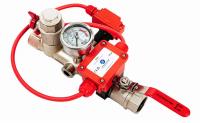 Add My Company
Add My Company
Sign In

A fire sprinkler is a pretty fundamental line of defence, should your building go up in flames. Dousing the fire with many litres of water can keep it at bay in many cases, or even extinguish it entirely if fortune is on your side. However, they aren’t perfect systems and can sometimes be prone to blockages.
This obviously isn’t ideal as a blocked sprinkler won’t be doing its job properly, putting homes, businesses and people at greater risk. With that in mind, let’s look at the ways fire sprinkler systems can be protected from blockages.
Here at Applications Engineering we supply high-quality Fire Sprinkler Valve Systems that cover the requirements of modern domestic and residential properties.
Foreign bodies from the water
You might not think that the water you are using to sprinkle on fire needs to be clean but dirty water can pose a problem for fire sprinkler systems. Using water from poorly filtered sources, or even completely unfiltered, can cause a foreign body to enter the pipes and clog important valves or nozzles. Even fine materials such as sand and grit can become lodged eventually in a sprinkler system, reducing their effectiveness or possibly even clogging them entirely.
You must understand where the water for your sprinkler system is sourced and whether it is filtered or treated at any stage. Not checking the origins of the water could result in a clogged sprinkler system if regular checks and tests aren’t completed.
Biological growth
A by-product of using unfiltered or raw water is the biological material that may be living inside entering your fire sprinkler system. Small organisms may enter your sprinkler system in their larval state but grow larger once they are inside the pipes, filters or valves. This can impact the pressure as these organisms may grow to be obstructions.
In an ideal world, you will use filtered water that is treated with a chemical like chlorine but it’s not always possible, perhaps due to environmental and regulatory reasons. You may need to carry out some water treatment of your own to ensure the safety of your sprinkler system.
Ice shards
Fires can break out in many places, even where it’s cold. Although the temperature in most of the UK is relatively warm compared to other countries, it still regularly drops below freezing. That’s not ideal for a sprinkler system that relies on water running through it to smother and extinguish fire.
Ice may form when the temperature gets cold enough, causing blockages throughout the system. Any water exposed to the elements or that is formed as a result of condensation is at risk of forming a frosty blockage. It’s important to check your fire sprinkler system’s temperature resistance and adapt it accordingly.
Cold storage, for example, is commonly filled with flammable materials such as cardboard and requires extra attention from a fire safety perspective. For that reason, a dry fire sprinkler system is a great choice as it is not water-based and therefore won’t become clogged in freezing temperatures.
Limescale deposits
Depending on where you live in the UK, you might find your water is either crystal clear or cloudy and filled with limescale. If you live in a hard water area, take a look inside your kettle and discover how much limescale attaches itself to the filament. That same limescale inside a fire sprinkler system will have a similar impact on most metal components, from the pipes to the valves and nozzles.
This can reduce the pressure in the system, creating an imbalanced or ineffective stream of water. Pressure switches rely on water pressure to do all of the work for them. If that pressure is impacted by limescale deposits, the switch may not activate when it is supposed to.
A way to prevent this is to source your sprinkler water from non-potable reservoirs or an area with softer water. However, this may not always be possible so extra safety checks and replacing clogged parts should also be considered.
Corrosion
Perhaps one of the worst causes of fire sprinkler obstructions is corrosion or rusting. It is caused due to a chemical reaction between the metal of the sprinkler system and water, oxygen or both. Unfortunately, it’s not possible to avoid this, which is why it is such a common occurrence.
Typically, a small amount of corrosion won’t impact your fire sprinkler’s capabilities but when it begins to mount up it’s more likely to cause a problem. Rust is a common corrosion instigator but it’s not the only one.
Galvanic corrosion occurs when two metals, or more, are in contact through an electrical charge in water. Microorganisms like fungi or bacteria can cause biofilm on corroding material to react and become an obstruction over time.
Ways to avoid these types of corrosion include choosing a corrosion-resistant material for pipes, such as CPVC. It’s possible to remove the oxygen from your sprinkler system and replace it with nitrogen, which is a more resistant gas and is less likely to cause corrosion.
Fire sprinkler valve system products at Applications Engineering
A healthy fire sprinkler system allows for peace of mind for fire marshals and building managers. Our fire sprinkler valve system products range from flow, level and pressure switches to our innovative Dual Port Valves.
At Applications Engineering we provide temperature, pressure and vacuum switches alongside our fire sprinkler products. Please contact one of our experts today for assistance with all of your control and instrumentation product needs.
For more information on How to protect your fire sprinkler system from blockages talk to Applications Engineering Limited
Enquire Now
List your company on FindTheNeedle.

